Optical Communication is the most modern mode of wired communication.
Optical communication is also the youngest mode of communication. However its capabilities supersede all other modes of communication.
Before optical communication the most of the communication was in radio and microwave domain which has frequency range orders of magnitude lower than the optical see Fig for the electromagnetic spectrum.
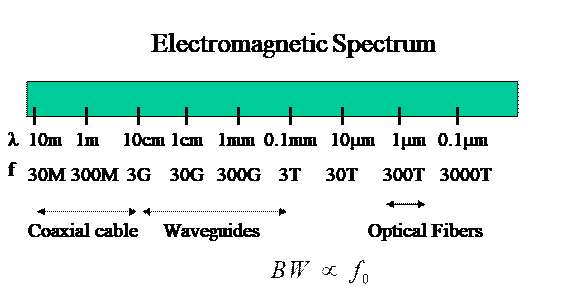

For good communication a system needs to have following things.
Since the bandwidth of a system is more or less proportional to the frequency of operation, use of higher frequency facilitates larger BW.
The BW at optical frequencies is expected to be 3 to 4 orders of magnitude higher than that at the microwave f requencies (1GHz to 100GHz).
Transmission media Alternative to the Optical
Communication.
There are various wired and wireless media used for long and short distance communication. Their broad characteristics are summarized in the following.


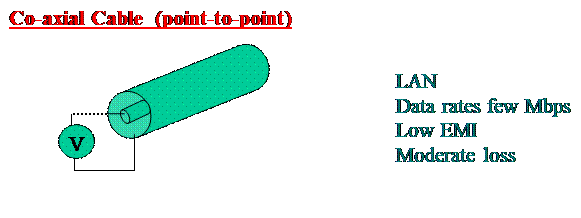

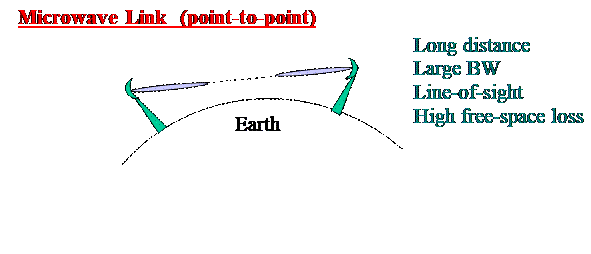
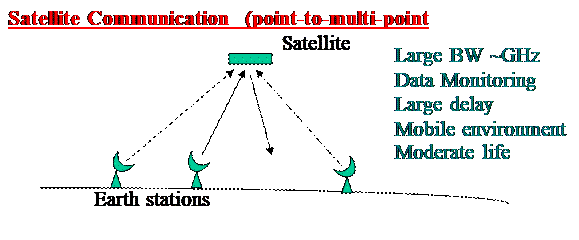

The first two media have a very limited bandwidth.
Microwave links and Satellite communication has comparable bandwidths as in principle their mode of operation is same but the spatial reach of satellite is far greater.
Before Fiber optic communication became viable, satellite communication was the only choice for long distance communication.
In the following we have comparison of Satellite and Optical communication.
Satellite vs Fiber Optics
Satellite and Optical communication will co-exist due their complementary nature
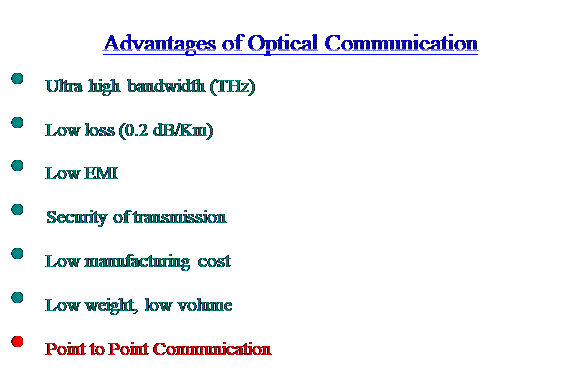

The optical transmission medium is the best in a sense that it has ultra wide bandwidth and very low attenuation.
The attenuation history is given in the following Figure.
Initially in early 1970s due to technology limitation, the optical fiber had a low loss window around 800nm. Also the semiconductor optical sources were made of GaAs which emitted light at 800nm. Due to compatibility of the medium properties and the sources, the optical communication started in 800nm band so called the ‘First window’.
As the glass purification technology improved, the true silica loss profile emerged in 1980s. The loss profile shows two low loss windows, one around 1300nm and other around 1550nm. In 1980s the optical communication shifted to 1300nm band, so called the ‘Second Window’. This window is attractive as it can support the highest data rate due to lowest dispersion.
In 1990s the communication was shifted to 1550nm window, so called ‘Third Window’ due to invention of the Erbium Doped Fiber Amplifier (EDFA). The EDFA can amplify light only in a narrow band around 1550nm. Also this window has intrinsically lowest loss of about 0.2 dB/Km. This band has higher dispersion, meaning lower bandwidth. However, this problem has been solved by use of so called ‘dispersion shifted fibers’.
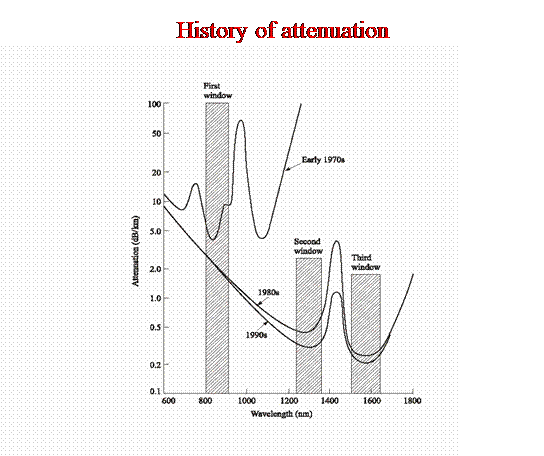

Both 1300nm and 1550nm band have approximately 100nm bandwidth each.
The frequency bandwidth is related to the wavelength bandwidth as

Where ![]() is the velocity of light in vacuum,
is the velocity of light in vacuum, ![]() is the refractive index of the medium,
is the refractive index of the medium, ![]() is the central wavelength of the band, and
is the central wavelength of the band, and ![]() is the wavelength bandwidth (also called spectral width).
is the wavelength bandwidth (also called spectral width).
For 1550nm window, ![]() , and
, and ![]() . For silica optical fibers
. For silica optical fibers ![]() . We therefore get
. We therefore get

So we have Approximately.

So, as a rule of thumb we can take for optical communication,
![]()
BASICS OF LIGHT
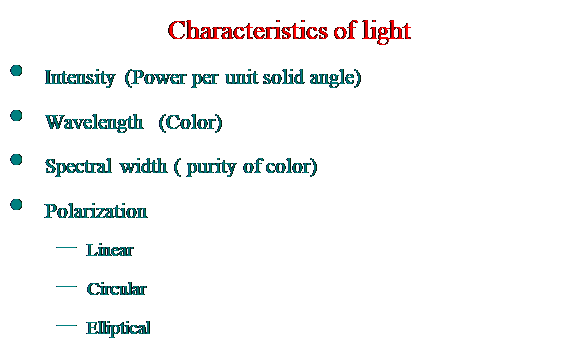

The characteristics of light are summarized in the following. The first three parameters scalar characteristics of light wheras the last parameter, polarization, describes the vector nature of light.
The choice of wavelength depends upon the loss profile of the medium. For optical fiber the wavelength has to be 1300nm or 1550nm for low loss.
The spectral width has direct bearing on the data rate which the medium can support. Larger the spectral width, smaller is the data rate. A semiconductor laser typically has spectral width about 20 to 100 times less compared to LED. Consequently, laser based communication can support much higher data rates.
Polarization in a intrinsic property of an electromagnetic wave.
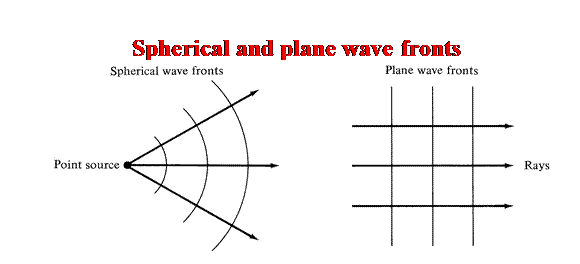

Light is an Electromagnetic wave.
It consists wave fronts. The lines normal to the wave fronts are called the light rays.
If the phase fronts are concentric spheres, the light is called a spherical wave, and if the phase fronts are parallel planes, the light is called a plane wave.
For a plane waves the rays are parallel whereas for the spherical wave, the emerge from the center of the spheres.
If the source is a a finite distance, the appropriate model is the spherical wave model, and if the source is assumed to be at infinite distance, the plane wave model is appropriate.
A plane wave can be represented by a wave function which is a composite function of space and time
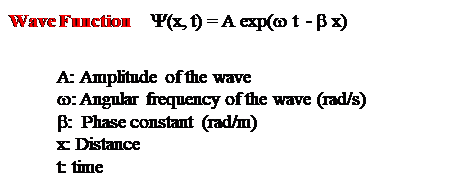

Snell’s Law
When light travels from one medium to other, it gets refracted. The relation between the angle of incidence and the angle of refraction is given by the Snell’s law. The Snell’s law is described in the following figure.
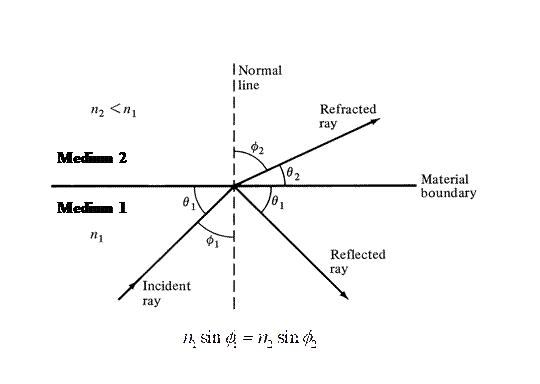

If the angle of incidence, ![]() is greater than the critical angle,
is greater than the critical angle, ![]() given by
given by
![]()
where ![]() are the refractive indices of the two media as shown in Fig., then the light is Total Internally reflected in medium 1. There is no refracted ray in that case.
are the refractive indices of the two media as shown in Fig., then the light is Total Internally reflected in medium 1. There is no refracted ray in that case.
BASIC FIBER STRUCTURE
An optical fiber basically is a solid glass rod surrounded by concentric glass shell as shown in Fig
. 

The rod is called the core and is made of highly purified glass. Most of the light energy in confined to the core.
The glass shell called cladding. The cladding shields optical fields so as not to get interfered by the outer layers of the fiber. The cladding is an essential part of an optical fiber.
The cladding is surrounded by the buffer layers. These layers have no role in propagation of light. They are essentially there to provide the mechanical support to the glass fiber and to protect the fiber from external damage.
Source: http://www.nptel.ac.in/courses/117101054/Optical%20Communication/seen/FOC-lecture1.doc
Web site to visit: http://www.nptel.ac.in/
Author of the text: indicated on the source document of the above text
If you are the author of the text above and you not agree to share your knowledge for teaching, research, scholarship (for fair use as indicated in the United States copyrigh low) please send us an e-mail and we will remove your text quickly. Fair use is a limitation and exception to the exclusive right granted by copyright law to the author of a creative work. In United States copyright law, fair use is a doctrine that permits limited use of copyrighted material without acquiring permission from the rights holders. Examples of fair use include commentary, search engines, criticism, news reporting, research, teaching, library archiving and scholarship. It provides for the legal, unlicensed citation or incorporation of copyrighted material in another author's work under a four-factor balancing test. (source: http://en.wikipedia.org/wiki/Fair_use)
The information of medicine and health contained in the site are of a general nature and purpose which is purely informative and for this reason may not replace in any case, the council of a doctor or a qualified entity legally to the profession.
The texts are the property of their respective authors and we thank them for giving us the opportunity to share for free to students, teachers and users of the Web their texts will used only for illustrative educational and scientific purposes only.
All the information in our site are given for nonprofit educational purposes